

Field Testing the 17 HMR
Field Testing the 17 HMR or 17HMR in a Thompson/Center Contender Carbine configuration and a CZ 452 Varmint rifle.
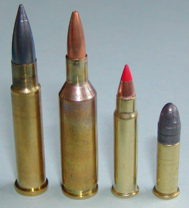 |
Left to right:
|
The 17 HMR (Hornady Magnum Rimfire) ammo has a 17 gr. hollow point (filled with polycarbonate) boat tail bullet with a 0.172" diameter and delivers a muzzle velocity of about 2550 fps (depending on the barrel length). There is 5.4 gr of what looks like Lil' Gun powder. The muzzle energy is 245 ft-lb and with a 1-10" twist, the bullet is spinning at 183,500 rpm. A typical 22 Long Rifle cartridge has a bullet weight of 40 gr. or more than twice the mass of the 17 HMR. I got my ammo, at Midsouth Shooters Supply.
FIRST MENTION.... Probably the first mention of the 17 HMR in a publication in 1992. Click here and scroll down to the bottom of the page.
| 17 HM2 Ammo
Ammo ordered: Ammo for testing. I have received the 17 HM2 ammo and done some preliminary testing.
I ordered one of the 10/22 barrel kits in 17 HM2 from EABCO.. I opted for the full bull in stainless steel barrel. After shooting the 17 HMR, I am not very much impressed with the 17 HM2. I haven't done extensive testing, but group sizes were about 1.5 MOA. That is good enough to hit ground squirrels out to about 125 yards. But about half of the grounds squirrels hit with the 17 HM2 are able to crawl to their holes. That doesn't happen very frequently with the 17 HMR. I would rather pay a little more for the 17 HMR ammo and have the extra muzzle velocity. |
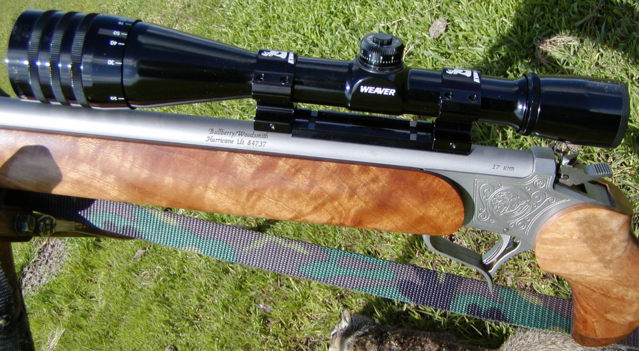
THE 17 HMR.... This 17 HMR is a Stainless Steel T/C Contender Carbine
with a Bullberry
Stainless Steel barrel, Full Bull contour, 0.810" diameter, 22" long
and bead blasted to eliminate the shine. The wood is "Utility Grade"
with the epoxy finish also from Bullberry
and the forearm is 12" long and is the target or beaver tail design.. The
base is a 92A Weaver base. The Rings are the KWIK-SITE KS-WEV-H rings and the
scope is a 15X by 40mm Weaver CKT-15. Fred Smith at Bullberry reamed the chamber
with minimum dimensions for better accuracy. Click here
for a large picture of the rifle. There is a 17 Caliber Forum at the RimFireCentral.com
page that has good info on the 17 HMR.
HANDGUNS.... The 17 HMR caliber is accurate in handguns
too. See the Freedom
Arms Model 97 in .17 HMR Excellent review of this fine handgun by Jeff
Quinn. See the Taurus
.17 HMR Tracker Revolver also reviewed by Jeff Quinn.
Taurus
makes a whole line of 17 HMR revolvers.
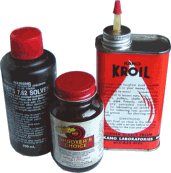
FIELD TESTING.... I was up at my Mountain Cabin testing the 17 HMR. Here is
the info on 11 groups shot at 100 yards. Each group was 5 shots. I am not sold
on EEZOX as being a good barrel cleaning preparation. Dale was helping me with
the photos and group shooting. So far, the 17 HMR is a better than MOA
caliber in my barrel if I clean with Sweet's 7.62 until there is no more sign of
copper. Then I finish cleaning with Shooters Choice MC#7/Kroil (half&half)
mix. The groups were shot from a solid benchrest with a front adjustable rest
and a sandbag rear rest. The temperature was about 75ºF.
| Group No. | Shooter | Group Size (in) | Comments |
| 1 | Al | 1.45 | Starting with a clean barrel. About 100 rounds through the barrel. Only cleaned with EEZOX. |
| 2 | Al | 1.17 | Variable winds, 3-5 mph, for Groups 1 - 6 |
| 3 | Al | 1.5 | |
| 4 | Al | 0.71 | Cleaned with Sweet's 7.62 then cleaned with Shooters Choice MC#7/Kroil (half & half) mix |
| 5 | Al | 1.07 | |
| 6 | Al | 1.03 | |
| 7 | Dale | 0.91 | Day 2. Calm winds for Groups 7 - 11 |
| 8 | Dale | 0.83 | |
| 9 | Al | 0.73 | Shooting over the Chrony |
| 10 | Dale | 0.59 | |
| 11 | Dale | 1.06 | |
| Average | 1.005 | Overall average group size Min=0.59 Max=1.5 | |
| Average | 0.866 | Average with no wind & after cleaning with Sweet's 7.62 & SC/K Min=0.59 Max=1.07 |
Some of the groups. The actual size of the square with the
circular center is 0.980" on a side. With the
chest area of a ground squirrel measuring about 3.5" in diameter, every one
of the rounds below would
have landed in the lethal area of a ground squirrel at 100 yards and beyond.
 Group 4 |
 Group 5 |
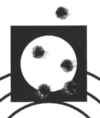 Group 6 |
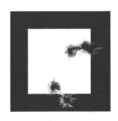 Group 9 |
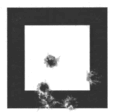 Group 10 |
Velocity Measurements for Groups 9-11
| 17 Hornady Magnum Rimfire velocity measurements 22" Bullberry Barrel. 3/31/2 Chrony about 15' in front of the muzzle (fps) | |||
| Group 9 | Group 10 | Group 11 | Combined Statistics |
| 2591 2621 2645 2584 2591 |
2532 2571 2590 2561 2602 |
2604 2584 2595 2626 2611 |
Mean = 2594 fps Standard Deviation=26.5 fps |
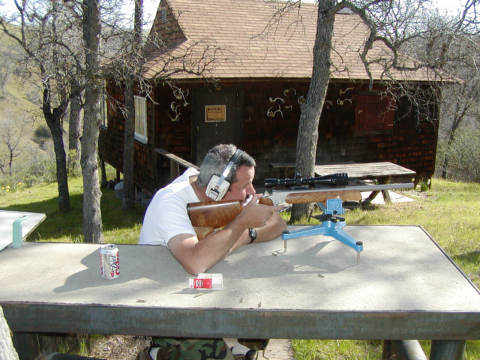
Dale is shooting a group with the 17 HMR caliber T/C Contender.
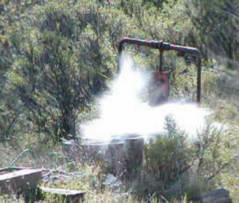
Diet Coke can full of water hit with the 17 HMR.
View the Movie Clip. It is quite impressive.
MOVIE CLIP.... Here is a movie clip of the 17 HMR hitting a Diet Coke can, filled with water, at a distance of about 30 yards. You are welcome to download the file and use it as you like. It is interesting to play it in slow motion. Here is the link to the movie clip - Download now: 17hmr.wmv (380Kb) in Windows Media Video format. If you would like a copy of the movie clip in the old Quick Time format, download 17hmr.zip. If you stop the action and view the single frame just before the can is hit, I think you can see the bullet about to hit the can. The top picture is the first frame after the hit and the second picture is the Diet Coke can showing the damage after the hit. There was no exit "wound". The movie clip was taken with an Olympus C-700 camera.
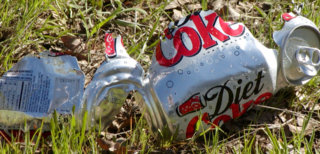
The Coke can after the impact.
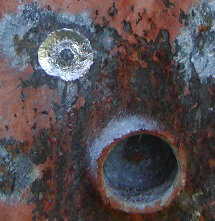
Here is the impact crater from a 17 HMR on a 3/4" steel plate at about 30
yards. The lower impact
was a 270 Win from close range a few years ago.
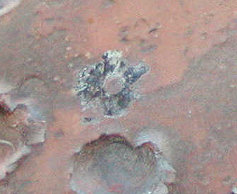
Hit a steel I-Beam at 296 yards. The 17 HMR bullet impacts the steel and welds
itself
to the steel surface. Dale tried to scrape the little 17 cal bullet off the
plate, but he
was just cutting into the copper base and couldn't remove it.
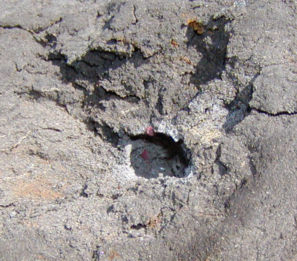
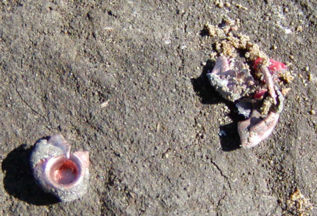
IMPACT CRATER.... This is an impact crater in damp sandy soil at about
135 yards. The crater is about 3/4" in diameter and about 1" deep. You
can see some of the red plastic from the nose tip. I used the camera's flash so
the bottom of the crater would be visible in the picture. I dug the jacket on
the left out of the crater. A second impact that I didn't get in good focus
produced the jacket and red plastic pieces. These little bullets are quite
frangible. I don't think you will have any ricochets and hear any of these
little guys go Zinnnng! Over 200 rounds on nearly flat terrain and I have not
heard a single ricochet.
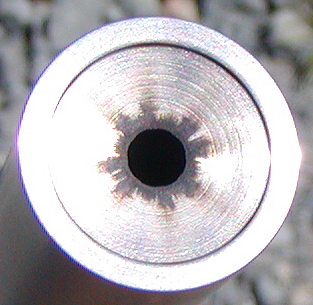
UNIFORM CROWN.... The people at Bullberry suggested that I use EEZOX on
the barrel. I cleaned it before shooting with EEZOX. Then I cleaned it again
after 50 rounds and here is a view after 100 rounds. Here is a picture of the
11° recessed crown. This shows marks from the EEZOX and powder after about 100
rounds have been fired. The uniformity of the pattern indicates a very well made
and uniform crown.
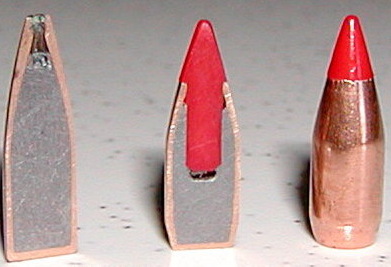
Dale sectioned a 25 gr .172 Hornady Hollow point and a 17 HMR bullet.
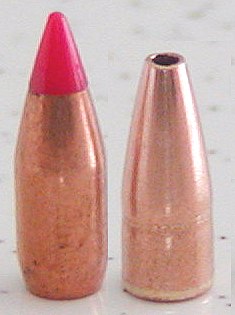
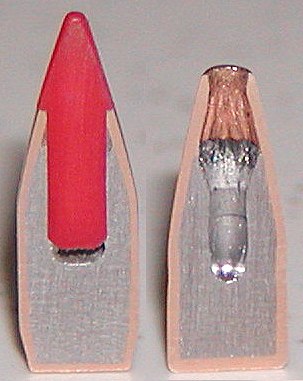
The CCI ammo finally arrived. Here is a comparison between the Hornady and CCI
ammo. Dale took these
pictures. It appears that the jacket is slightly thicker in the CCI ammo and the
hollow point is much smaller
than it is in the Hornady ammo, assuming the plastic adds very little strength.
The first few ground squirrels
shot with the CCI ammo crawled away from good hits. The bullets penetrated
completely and appear to
be less destructive/frangible as the Hornady bullets.
Here are three 100 yard 5 shot groups shot in the order shown
without barrel cleaning.
Light variable wind of ~5 mph from left to right
The accuracy of the CCI ammo, in my rifle, is very similar to the Hornady ammo.
Note: The square is 1.0" on a side
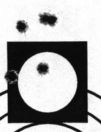 CCI ammo. Measured 0.848" |
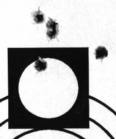 Hornady ammo. Measured 0.858" |
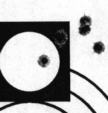 CCI ammo. Measured 0.688" One hole in the black |

Rifle and scope on my concrete benchrest up at my mountain cabin.
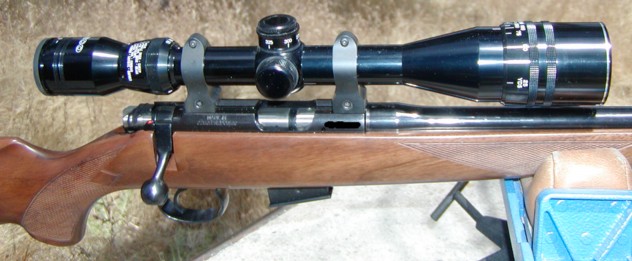
Scope is a Tasco 4-16X by 40 mm TR mounted with Warne Rings.
CZ 452 AMERICAN.... First impressions. The machine work looks very well done. The fit and finish on the metal looks good. The barrel touched the right side of the stock and there was a noticeable gap on the left side. I opened up the barrel channel to completely free float the barrel. I mounted a Tasco 4-16X by 40mm TR scope and am using the "G" yardage ring. It is very close to the bullet drop info out to 250 yards. The "G" Drum is for a 30/30 Win shooting 170 gr factory bullets. I kissed the crown with my spherical grinding stone. It was very good to start with and in about 2 or 3 minutes of turning it very lightly by hand, the crown cleaned up nicely. I also adjusted the trigger down to 2.5 lb, but it still has noticeable creep. I will work on that later.
Drum Click Count for the Tasco 4-16X by 40mm TR Scope
for 150 to 500 yards.
|
Drum |
150 |
200 |
250 |
300 |
350 |
400 |
450 |
500 |
|
F |
1.5 |
4 |
7 |
10 |
15 |
19 |
24 |
29 |
|
E |
2 |
4 |
7 |
11 |
17 |
24 |
28 |
33 |
|
C |
2 |
5 |
9 |
14 |
19 |
25 |
31 |
39 |
|
D |
3 |
7 |
12 |
17 |
23 |
29 |
37 |
45 |
|
B |
2 |
5 |
10 |
16 |
23 |
30 |
39 |
48 |
|
A |
5 |
9 |
15 |
22 |
29 |
37 |
45 |
|
|
G |
6 |
14 |
25 |
39 |
|
|
|
|
I use Drum D on my 243
Win caliber with 100 gr bullets.
I use Drum G on my 17 HMR with the 17 gr
Hornady ammo.
Here is a scanned view of the Range Drum Tables
for the scope. Click
Here.
The 50 yard 5 shot proof target from the factory measured 0.8" and showed lateral dispersion which would be expected with the barrel touching the stock on the right side.
Five shot groups with the CZ 452 American Rifle at 100 yards
with the Hornady ammo.
The average group size for 5 groups is 0.714".
 0.948" |
 0.368" |
 0.948" |
 0.848" |
 0.458" |
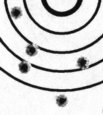
A typical group with the early CCI ammo.
This group measured about 1.3" and obviously the CZ 452 American didn't
perform well with the CCI ammo.

CZ 452 VARMINT.... Here is my CZ 452 Varmint in 17 HMR. It is a tack
driver. The varmint weight barrel is 21" long from the muzzle to the
bolt-face. The scope is a Weaver V24 with a Mil Dot reticule. The crosshairs and
dots are quite large. I would rather have had the fine duplex with a fine dot,
but thought I would try a Mil Dot. The rings are the BKL
3/8" Dovetail Model 257-A rings. They were quite reasonably priced for
the good quality. They make a very solid and sturdy mount. After mounting the
scope, on the first outing, I sighted in on a cardboard box and started
controlling the ground squirrels that were drilling holes in the Island's levee.
I went 19 straight without a miss. I haven't shot the rifle from a benchrest
yet. But all indications are that it will group very well. The factory stock has
really very striking wood grain. The factory finish doesn't bring out the fiddle
back figure like a good stock finish would. I usually leave the scope set
at 18X for most ground squirrel shooting.
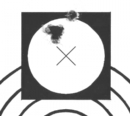
The square is 1.25" on a side.
I was finally able to put this rifle on the benchrest and shoot 5 shot groups at 100 yards with the Hornady ammo. The scope was left on 18X power. The first group out of a clean barrel was about 3/4" high, but it settled in on the second group. I quit wasting ammo and didn't even take the scope caps off and decided that this was good enough! No wonder I was doing so well on ground squirrels with it.
Table of 20 shots with the CZ 452 Varmint rifle and the
Hornady ammo.
Statistics of the velocity data.
1 2721.0000 fps |
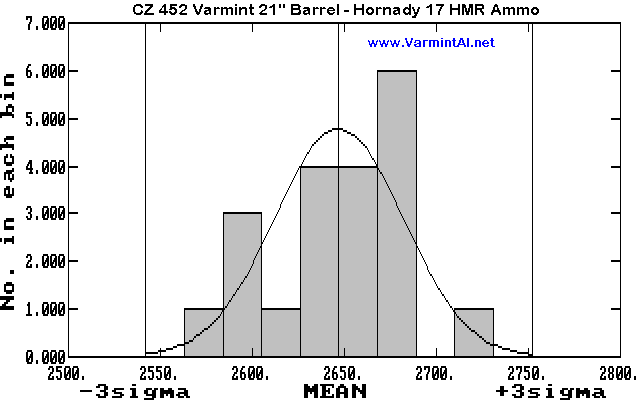
The 21" barrel on the CZ 452 Varmint rifle delivers an
average velocity of 2647 fps with the Hornady ammo.
The curve is a normal distribution with the same mean and standard deviation as
the velocity data.
|
Originally posted
on the Accurate Reloading Forum. Let me start by saying I do not own or shoot a .17 HMR of any make or
model, so I am not grinding ANY axe here. |
I found this post on The
Firearms Forum
| Originally Posted by Contenderizer I can't attest to the accuracy of the graphs, but they are very interesting. I have never been a fan of the 17s because of their poor terminal ballistics. Given my type of shooting - 50-100 yds - I think I did the right thing sticking to 22LR. |
| Have fun! I felt the very same way. I had read about the 17, but yawned, until I shot a 17 HMR last week. All of my shooting of small game "was" under 100 yds, but even out to 100 you had to really watch your range with a 22LR and adjust for it. Don't have to do that with a 17. Another problem is the 22LR bullets skipping off of everything, again not a problem with the 17. As far as clean kills, the 17 hands down over the 22LR. I have 20, 22LR rifles. I will now only hunt with one either using shorts or CB caps (very close range). All of my other hunting I was doing with a 22LR will now be done with a 17 HMR. I will still plink with my 22's, and teach others to shoot with them, but with less than a week shooting the 17 HMR, and just one day hunting with it, no way will I go back. What ever you do, DON'T EVER SHOOT A 17 HMR. What ever you thought you knew about 22 rim fires, and loved about them, will be lost forever. It's like dumping your wife for Miss America. Posted by R Long |
Ammo Comparison test with a Marlin 917V
Listed below are some tests groups that Kevin
from South West Missouri fired on 8/23/06.
Distance: 100 Yards, 5 shot groups from a bench.
Gun: Marlin 917V, polished sear and trigger, lighter trigger spring,
Scope: Bushnell 4x12x40
Cleaning before each group: One wet patch with 50/50 Shooters Choice/Kroil then
one dry patch. No fowling shot.
AMMO COMPARISON
| Group | Group Size (in) |
Mfg | Ammo |
| A | 0.364 | Winchester | Supreme V-Max 17 gr |
| B | 0.588 | Remington | PR17HM1 AccuTip-V 17 gr |
| C | 0.594 | Hornady | 17 gr V-Max |
| D | 1.040 | CCI | TNT HP 17 gr |
| E | 1.069 | Hornady | 20 gr XTP |
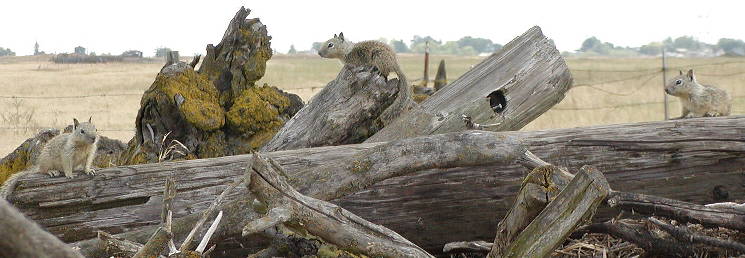
Some young ground squirrels posing for the camera.
|
|
|
|
Ballistic
Calculations for the 17 HMR
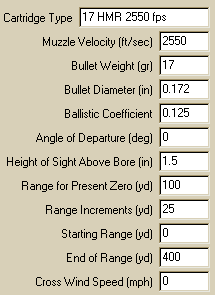
Bullet ballistic coefficients found in literature and other
ballistic programs are listed at Standard Conditions.
This is what was used.
Elevation Sea Level
29.53 in Hg
59º F
78% Relative Humidity
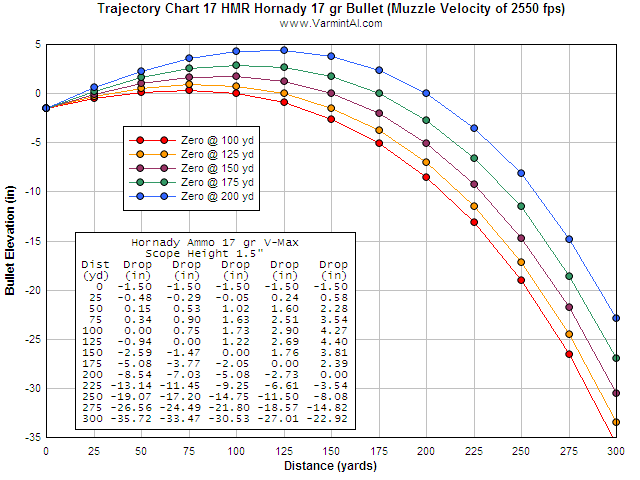
Drop Table for the 17 HMR with zeros from 100 to 200 yards.
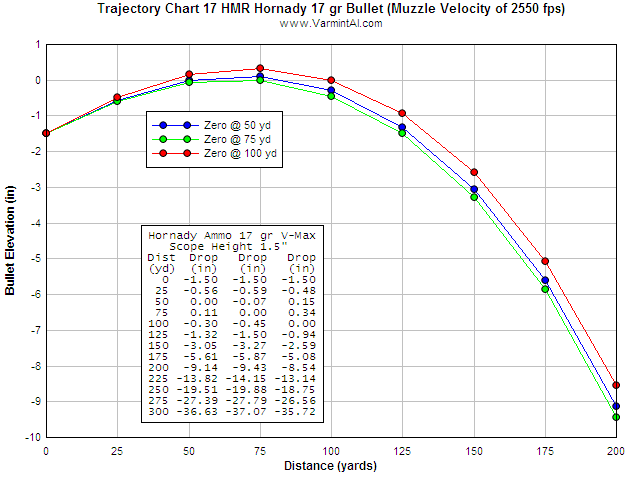
Drop Table for the 17 HMR with zeros from 50 to 100 yards.![]()
Scope
Click Table to Paste on your Rifle Stock![]()
| Hornady 17 gr. 17 HMR MV=2550 |
Hornady 17 gr. 17 HMR MV=2550 |
Hornady 17 gr. 17 HM2 MV=2100 |
Hornady 17 gr. 17 HM2 MV=2100 |
| Click Size 0.125 Yard Drop Click 100 0.0 0 125 0.9 7 150 2.6 14 175 5.1 24 200 8.5 35 225 13.1 47 250 18.8 61 275 26.6 78 300 35.7 96 325 46.7 115 350 59.7 137 375 74.3 159 400 91.4 183 |
Click
Size 0.250 Yard Drop Click 100 0.0 0 125 0.9 4 150 2.6 7 175 5.1 12 200 8.5 18 225 13.1 24 250 18.8 31 275 26.6 39 300 35.7 48 325 46.7 58 350 59.7 69 375 74.3 80 400 91.4 92 |
Click Size 0.125 Yard Drop Click 100 0.0 0 110 0.5 4 120 1.2 9 130 2.1 13 140 3.1 18 150 4.3 23 160 5.7 29 170 7.4 35 180 9.2 42 190 11.2 48 200 13.7 55 210 16.3 63 220 19.2 70 230 22.4 78 240 25.9 87 250 29.6 95 |
Click
Size 0.250 Yard Drop Click 100 0.0 0 110 0.5 2 120 1.2 5 130 2.1 7 140 3.1 9 150 4.3 12 160 5.7 15 170 7.4 18 180 9.2 21 190 11.2 24 200 13.7 28 210 16.3 32 220 19.2 35 230 22.4 39 240 25.9 44 250 29.6 48 |
HANDY TRAJECTORY PASTE ON.... Here is a handy drop and scope elevation click table you can print out and tape to your stock for long range shooting with the 17 HMR and 17 HM2 Hornady ammo. This requires that you have your rifle zeroed for 100 yards. Select the list with the correct size elevation clicks for your scope. The distance is in yards and the drop is in inches below the line of sight. The click are rounded to the nearest click. Most scopes have either a 0.125 or 0.25 inch click size. Some scopes have a 0.250 Minute of Angle (MOA) click size. One MOA is about 1.0472 inches and 0.25 MOA is 0.261 inches or a difference of only about 4%. The scope height was 1.5 inches for all these tables.
| Hornady XTP 20 gr. 17 HMR MV=2375 |
Hornady XTP 20 gr. 17 HMR MV=2375 |
| Click Size 0.125 Yard Drop Click 100 0.0 0 125 1.2 8 150 3.2 17 175 6.1 28 200 10.2 41 225 15.3 55 250 22.6 73 275 31.2 91 300 41.7 112 325 54.1 134 350 68.3 157 375 84.9 182 400 103.7 208 |
Click Size 0.250 Yard Drop Click 100 0.0 0 125 1.2 4 150 3.2 9 175 6.1 14 200 10.2 21 225 15.3 28 250 22.6 37 275 31.2 46 300 41.7 56 325 54.1 67 350 68.3 79 375 84.9 91 400 103.7 104 |
SCOPE HEIGHT.... The scope
height is the distance between the rifle's bore axis and the scope's axis.
The easiest way I have found to measure the scope height on a bolt action rifle
is:
A = One half the Bolt diameter
B = One half the Scope's tube diameter (where the scope rings are).
C = Distance between the top of the Bolt and the Bottom of the Scope.
Scope Height = A+B+C
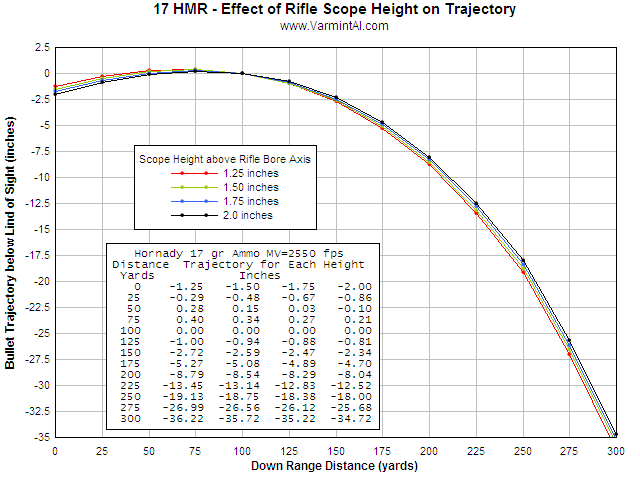
SCOPE HEIGHT vs TRAJECTORY.... This chart shows the small variation in
trajectory for scope heights from 1.25 to 2.0 inches.
Notice that at 300 yards, the difference between a scope height of 1.25 and 2.00
inches only results in a difference of 1.50 inches
in the Point of Impact. For most scope heights the calculations at a scope
height of 1.5 inches should be very close to any
reasonable scope height.
Ballistic Trajectory Calculations for the 17 HMR at 2550, 2600, and 2650 fps Muzzle Velocities
2550 fps Muzzle Velocity
Range Bullet Velocty Eng TOF
(Yds) Drop (in) (fps)(ft-lb) (sec)
0 -1.50 2550 245 0.00
25 -0.48 2373 213 0.03
50 0.15 2205 183 0.06
75 0.34 2045 158 0.10
100 0.00 1893 135 0.14
125 -0.94 1750 116 0.18
150 -2.59 1617 99 0.22
175 -5.08 1495 84 0.27
200 -8.54 1381 72 0.32
225 -13.14 1280 62 0.38
250 -19.07 1193 54 0.44
275 -26.56 1125 48 0.50
300 -35.72 1070 43 0.57
325 -46.68 1024 40 0.65
350 -59.66 985 37 0.72
375 -74.34 952 34 0.80
400 -91.42 921 32 0.88
|
2600 fps Muzzle Velocity
Range Bullet Velocty Eng TOF
(Yds) Drop (in) (fps)(ft-lb) (sec)
0 -1.50 2600 255 0.00
25 -0.51 2420 221 0.03
50 0.11 2250 191 0.06
75 0.31 2088 165 0.10
100 0.00 1934 141 0.13
125 -0.89 1789 121 0.17
150 -2.45 1653 103 0.22
175 -4.82 1527 88 0.27
200 -8.12 1411 75 0.32
225 -12.51 1306 64 0.37
250 -18.18 1215 56 0.43
275 -25.35 1142 49 0.49
300 -34.17 1084 44 0.56
325 -44.74 1036 40 0.63
350 -57.23 995 37 0.71
375 -71.62 961 35 0.78
400 -88.13 929 33 0.86
|
2650 fps Muzzle Velocity
Range Bullet Velocty Eng TOF
(Yds) Drop (in) (fps)(ft-lb) (sec)
0 -1.50 2650 265 0.00
25 -0.53 2468 230 0.03
50 0.08 2295 199 0.06
75 0.28 2131 171 0.09
100 0.00 1975 147 0.13
125 -0.84 1827 126 0.17
150 -2.33 1688 108 0.21
175 -4.58 1560 92 0.26
200 -7.73 1442 78 0.31
225 -11.92 1333 67 0.36
250 -17.35 1238 58 0.42
275 -24.21 1160 51 0.49
300 -32.69 1098 46 0.55
325 -42.88 1048 41 0.62
350 -54.92 1006 38 0.69
375 -68.99 970 35 0.77
400 -84.96 937 33 0.85
|
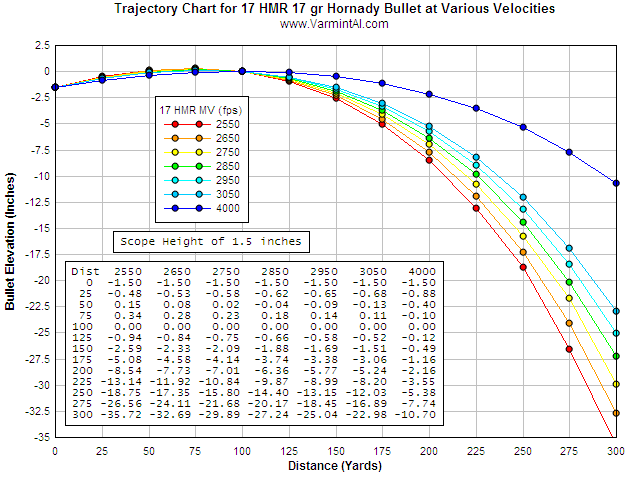
Some people are getting higher velocities out of their 17 HMR rifles than the
advertised 2550 fps.
Here is a chart to show the bullet drop for a range of muzzle velocities form
2550 fps to 3050 fps.
I added the muzzle velocity of 4000 for comparison of what might be achieved
with the 17 Ackley Hornet.
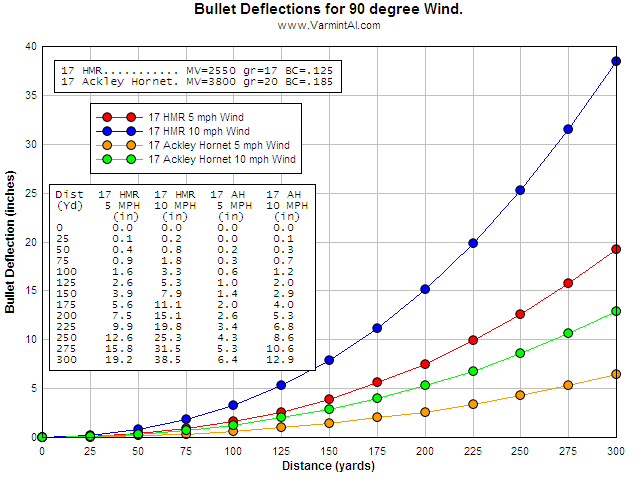
Comparison between the 17 HMR, 17 HM2 and a
22 LR.
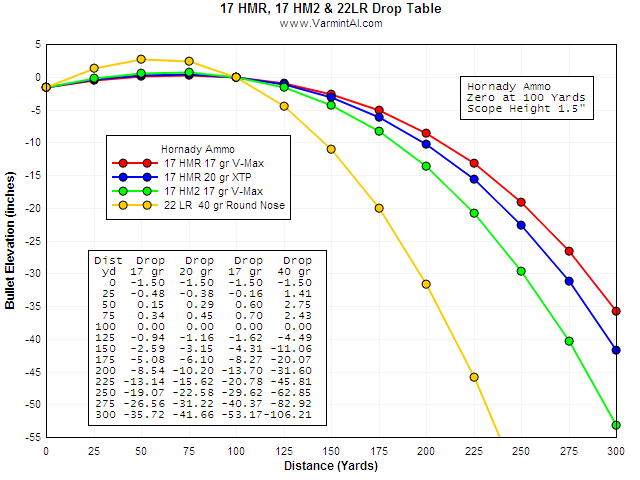
Comparison between the 17 HMR 17 and 20 gr ammo. The 20 gr XTP bullet's BC was
back
calculated from Hornady's trajectory chart. I included the 17 HM2. Using the
muzzle velocity quoted by
Hornady and the muzzle energy, it indicated that the 17 HM2 uses the same bullet
as the 17 HMR.

LOSE 66.5 YARDS WITH THE 17 HM2.... Notice that the 17 HM2 velocity
is similar to the 17 HMR velocity after the 17 HMR has traveled about 66.5
yards. Or in other words, the 17 HMR gains you about 66.5 yards over the 17 HM2.
With the 17 HM2 you have to move 66.5 yards closer to the target to be
equivalent to the 17 HMR. Assuming a 1-9" twist, the exception is that the
spin velocity of the 17 HMR bullet will remain about 204,000 RPM (spin energy of
0.44 ft-lb) down range and the 17 HM2 bullet will be 168,000 RPM (spin energy of
0.30 ft-lb).
SOUND VELOCITY.... The velocity of sound in air is approximately 1130 feet/sec. or 770 miles per hour at room temperature of 70 deg F. The speed varies with the temperature of air, such that sound travels slower at higher altitudes or on cold days.

Notice that the 17 HM2 energy curve would fall on the 17 HMR curve after about
66.5 yards. Also note
that the 22 LR has more retained kinetic energy past 210 yards than any of the
17's. But even with
the higher retained energy, you have to be able to hit the target for it to
accomplish anything.
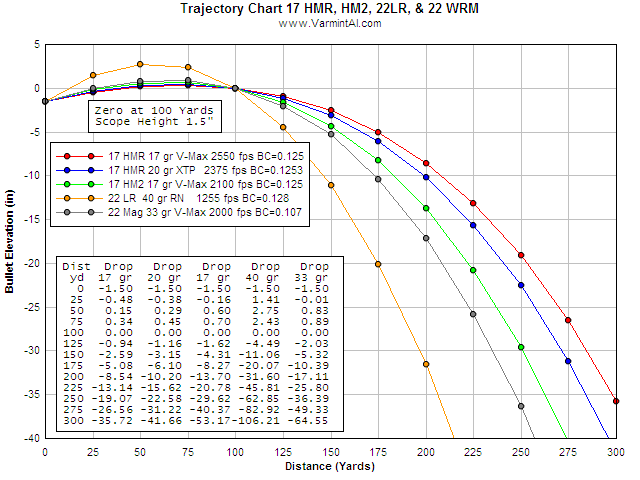
This chart includes the 22 Mag 33 gr V-Max with a 2000 fps muzzle velocity.
Rifle Twist Bullet Bullet Velocity Spin Powder Recoil Bullet Energy Caliber Wt Dia Mass Mass Energy Linear Spin (lb)(T/in) (in) (Gr) (fps) (rpm) (Gr) (ft-lb) (ft-lb) (ft-lb) -------------------------------------------------------------------------------- 6.0 10.0 0.172 17 2550 183600 5.5 0.25 245 0.36 17 HMR 6.0 14.0 0.224 40 2800 144000 12.0 1.50 696 0.88 22-Hornet 6.0 12.0 0.224 50 3300 198000 26.0 4.36 1209 2.08 223 Rem 6.0 10.0 0.243 55 3600 259200 44.0 8.67 1583 4.61 243 Win 8.0 10.0 0.172 17 2550 183600 5.5 0.19 245 0.36 17 HMR 8.0 14.0 0.224 40 2800 144000 12.0 1.12 696 0.88 22-Hornet 8.0 12.0 0.224 50 3300 198000 26.0 3.27 1209 2.08 223 Rem 8.0 10.0 0.243 55 3600 259200 44.0 6.50 1583 4.61 243 Win 10.0 10.0 0.172 17 2550 183600 5.5 0.15 245 0.36 17 HMR 10.0 14.0 0.224 40 2800 144000 12.0 0.90 696 0.88 22-Hornet 10.0 12.0 0.224 50 3300 198000 26.0 2.62 1209 2.08 223 Rem 10.0 10.0 0.243 55 3600 259200 44.0 5.20 1583 4.61 243 Win |
Recoil Calculations for the 17
HMR, 22-Hornet, 223 Rem and 243 Win shooting varmint bullets.
Notice the extremely low recoil from the 17 HMR. That is why the bullet impacts
can be seen through the scope.
|
Mike's Penetration Test in Lead
All 22 LR's were shot from 20 yards with Iron Sights
(had a little overlap with the The Stinger was very impressive. American Eagle had
deep penetration.
|
|
Greg's Penetration Test Hornady vs. CCI Ammo I am quite impressed with your website devoted to field testing of
the 17HMR. I find this type of activity very interesting, as I too like
to "test" mechanical objects, weapons, etc. to determine
penetration, etc.
|
Bill's Penetration test #1 - .17 HMRSince there is still a lot of controversy about the
penetration ability of the .17 gr. V-Max bullet, thought I would do a
little testing. I used 10 prickly pear pads as they are full of moisture
and fiber and relatively tough and may come close to simulating muscle
tissue.
Bill's Latest Penetration Test
Comparing the |
Not all
17 HMR's need to be single shots!
Here are three of Ted's rifles chambered in 17 HMR. Ted has done a beautiful job
on these works of art.

The caption reads:
Ruger 77/17, BR TH Tigerwood Laminate, GM .17 Barr
Leupold Vari III 6.5-20X50 LRT, Millet Nickel Rings
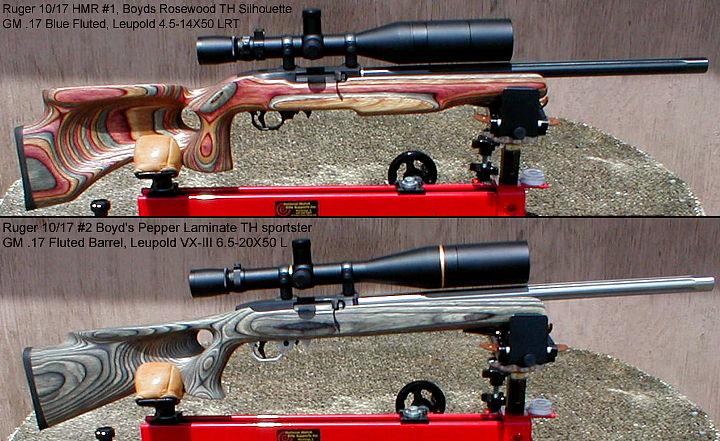
Ted must have a difficult time selecting which rifle to to shoot.
More info on the 17 HMR Ammo from Jack, a gunsmith friend of mine:
Hi Al,
As promised, here are a few photos of what seems to be on it's way to becoming your go-to round for day-to-day little-critter work. As I mentioned in a previous e-mail, one does not simply pull one of these bullets as with, for example, a .22LR. This pup has a very stout crimp! This undoubtedly is a factor in producing the low velocity SD's that are being reported. To remove the bullet unscathed I had to first remove the powder, then slit the neck and peel back the brass. Powder weight in each of the two rounds I "necropsied" was 5.4 grs. Powder form was that of a flattened ball, light silver color. Approximately 5-10% of each charge was a darker ball component. This leads me to believe that Hornady is blending this powder, a common industry practice. Both bullets weighed exactly 16.7 grs.
This shot of the bullet full diameter reflects the measurement to the capability of my caliper, that is to say, 0.0005". Measurement was verified with two different 0.0001" micrometers. They both indicated a true diameter of 0.1717" for this bullet. Measurements were taken both above and below the crimp groove on the full-diameter portion, and were identical.
Here's a measurement taken in the crimp groove. As mentioned earlier, this is a healthy crimp.
Just a shot of the bullet "posed" atop an empty case, showing the crimp groove rather well.Al, I hope this is about what you were looking for with this little "hummer".
73's de Jack Thanks Jack... from Varmint Al
(Jack is a new ham radio operator. Soon he will be on 2m packet radio)
17 HMR Field
Testing on Ground Squirrels
Day 1
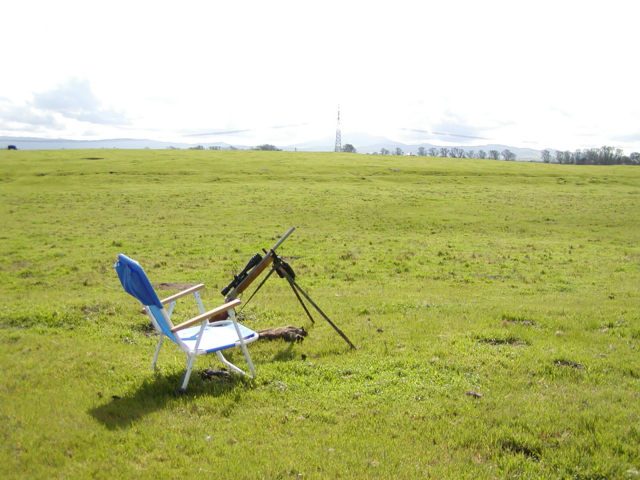
The location is a pasture with prize Black Angus cattle. Mt Diablo, in the
clouds, is in the center behind the power line tower.
I use the short chair for shooting so I don't have to sit in the wet grass and
besides it is more comfortable.
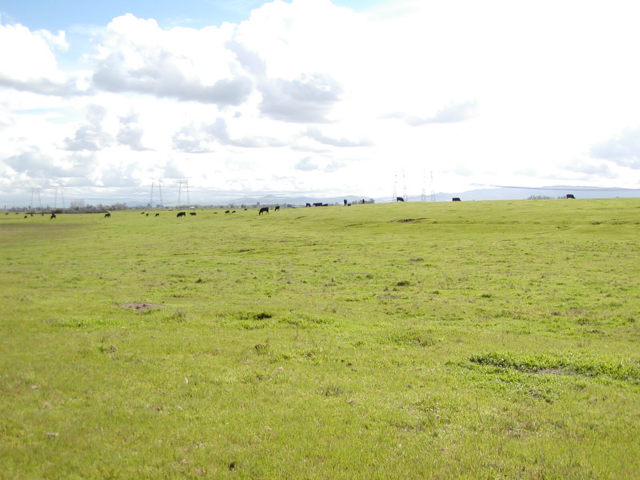
Some of the Black Angus cattle with a few ground squirrel holes. The shooting
was done in between the rains.
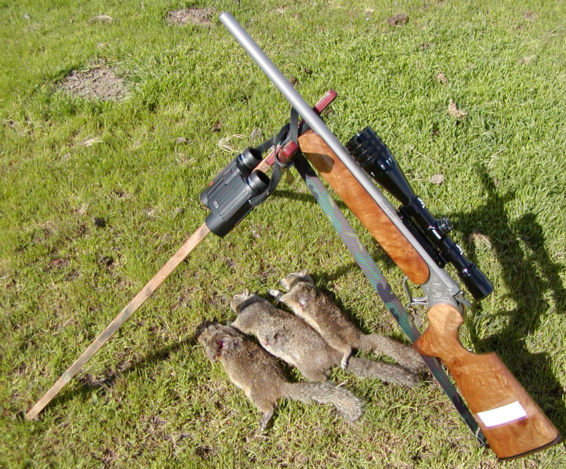
GETTING ON TARGET.... Getting on the target was easy. The first shot at a
20 yard target box was about 6" low. Then it took a few rounds to get
sighted in at about 80 yards. The cows moved in on me and I had to quit the
target work. I moved away from the cattle and missed the first few squirrels. I
finally shot some rocks on squirrel mounds and was able to bring it on zero at
about 100 yards. Here are the first three ground squirrels.
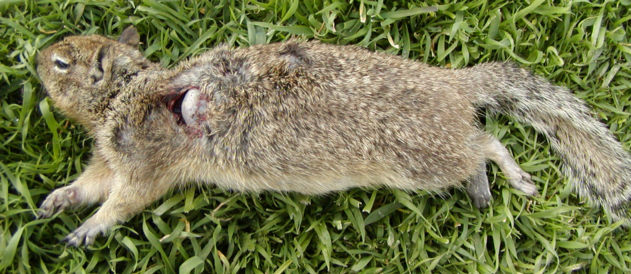
WATCH THE IMPACTS THROUGH THE SCOPE....The recoil is very light and one
can easily watch the bullets impact while looking through the scope even at 15X.
I could see the impact as each squirrel was hit and it was very easy to hear the
whooop! as the bullet connected. There was not the destructive damage of the 17
Mach IV and none of the little 17 gr bullets exited a ground squirrel. I got a
total of 10 ground squirrels and was able to find 5 or 6 of them. A couple I
just couldn't locate and two made it down the holes.
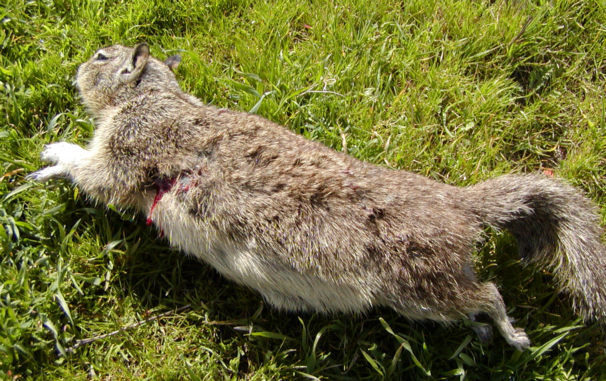
The little 17 gr bullet at 2550 fps turns out the lights and deposits all its
energy inside with no exit wound.
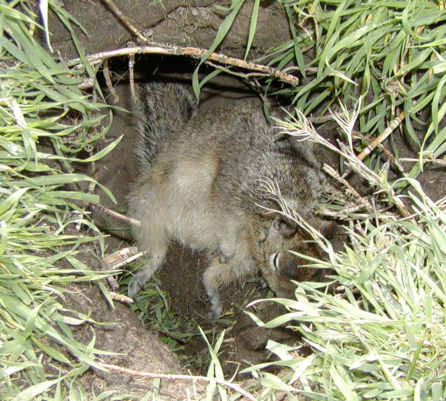
Lights out. Standing at the edge of his hole, this one folded in his hole.
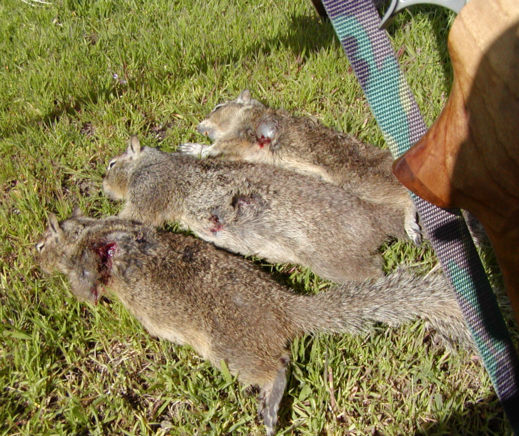
TYPICAL DAMAGE TO GROUND SQUIRRELS.... Here is a close-up of the first
three ground squirrels, showing the typical damage. These were shot at from 100
to 140 yards. There was a 10 to 15 mph crosswind most of the time. I was
holding into the wind about 1/2 a squirrel. When the wind changed
directions, I was off by more than a squirrel. I am not sure about the
wind drift since I haven't sighted in the rifle on the benchrest yet in calm
wind conditions.
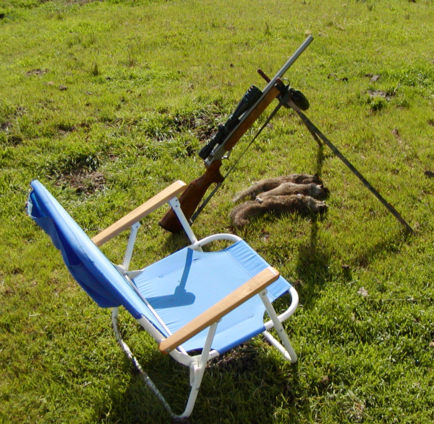
IN SUMMARY.... My overall impression is that this little 17 HMR is an
excellent caliber for ground squirrel-sized varmints. The bullet is very
frangible. When I was checking my zero on squirrel mounds, I could see the dust
from the bullet's breakup right through the scope even in wet dirt. While it
does not rip apart a ground squirrel like a 17 Mach IV or a 223 Ackley Improved,
with solid hits, it stops them in their tracks out to at least 140+ yards. The
recoil is so light that it is easy to watch the bullet's impact through the
scope even at 15X setting and probably even at a much higher magnification.
After I had the rifle sighted in, I went 8 straight from about 80 yards to 140+
yards. They were all in about the same direction with about the same level of
wind that I would estimate at between 10 to 15 mph. The noise level is very
mild. I didn't wear any ear protection and the report seemed to be no louder
than the higher velocity 22LR rounds like a CCI Stinger. The velocity of the 17
HMR is sufficient that there appears to be no delay while the bullet is
traveling the 100+ yards to the target. I believe the 17 HMR is not powerful
enough for coyotes. Using the 17 HMR for coyotes would be like going elephant
hunting with a 243 Win loaded with 55 gr Nosler Ballistic tips. The Bullberry
barrel appears to be very consistent. I will know more about its accuracy when I
can put it on my benchrest up at my cabin. All in all, I am very pleased with
the new 17 HMR.
17 HMR Field
Testing on Ground Squirrels
Day 2
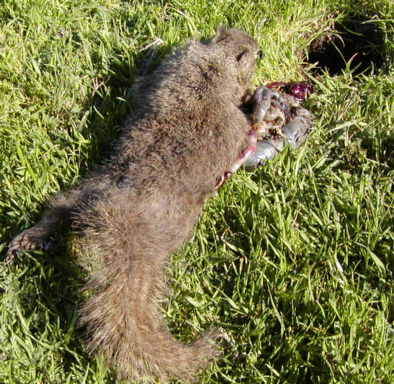
This unlucky ground squirrel was taken at about 70 yards. This is the most
damage I have seen to date.
I got a few more ground squirrels today. Got one at 172 yards and another at 163
yards.
For these two, on all four, I was holding about 2" over their backs. Bang,
Plop!
There was very light wind today and I have the windage set pretty well on the
scope now.
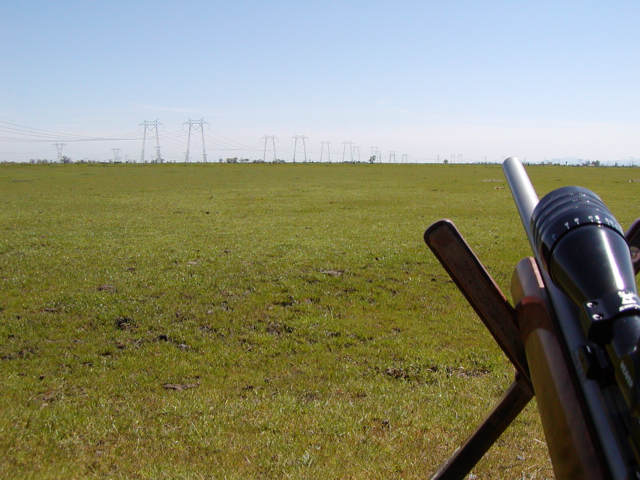
Here is a view looking east. When I first got here, there were 6 ground
squirrels standing up at from 30 to 100 yards.
Six rounds from the 17 HMR fixed that and that should make the cattle rancher
happy.
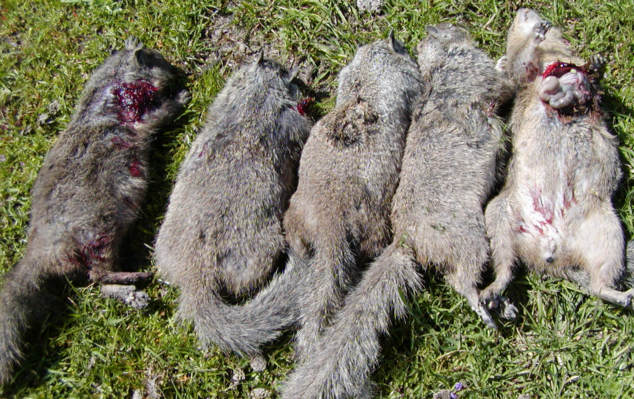
ACCURATE SHOT PLACEMENT POSSIBLE.... Here are 5 of the 6 squirrels. From
the left to right they were taken at about 100, 90, 90, 60, and 35 yards. One of
the ground squirrels must have made it down the hole, because I couldn't find
it. Later in the day, I took some longer shots. I actually connected on 4
ground squirrels from 275 to about 320 yards. They just dropped and quivered. I
was holding over about a foot on the long shots and about 6" into a mild 5
mph wind. On one shot at about 200 yards, I actually saw the bullet hit the bank
about 10 ft behind the ground squirrel after completely penetrating it. The
coyotes will be coming in tonight for their feast. The 17 HMR does not tenderize
the ground squirrels as much as the 223 Ackley Improved.
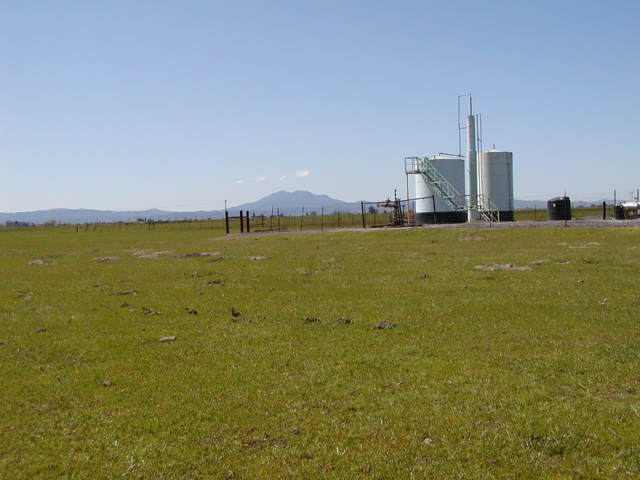
THE HUNTING GROUNDS.... A view of Mt Diablo with
some ground squirrel mounds at about 50 yards. No! I don't shoot in this
direction. To get these ground squirrels, I would move over to the right to get
a clear backdrop. There are probably 250 or more ground squirrels in this
80-acre pasture. Then there is the next section with a few thousand ground
squirrels. Then there is another couple of sections on the other side of the
road.
| A VERY FINE LINE.... I am very careful to only
"control" the ground squirrel population. I have to walk a
very fine line. If I shoot too many, they might not survive and the
field will be barren. If I leave too many in the field, the rancher
might use poison and kill them all. A surviving population of ground
squirrels is a good thing and besides, I don't want to work myself out
of a job. |
![]() Finally,
in my view, the 17 HMR is a keeper!
Finally,
in my view, the 17 HMR is a keeper!
MORE COMMENTS.... I got excited about the 17 HMR because it was really something new and filled a gap in shooting enjoyment. As we get more crowded and the open country becomes more and more scarce, the relative quiet and accurate 17 HMR is an excellent choice. I had a Contender Carbine barrel ordered within hours after is was first available from Bullberry and long before the other rifle manufactures were even considering an offering.
THE SECOND AMENDMENT CALIBER.... I call the 17 HMR the Second Amendment Caliber. Anyone who owns a firearm views the Second Amendment differently than liberal tree huggers. Many people who were not enjoying shooting sports have joined the 17 HMR bandwagon and are having a really good time again or, in many cases, for the first time. The 17 HMR is expanding the number of gun owners like no other caliber that has come along in quite a long while.
COULD IT BE?.... Could it be true that the 17 HMR was a Right Wing Conspiracy to get more people to own a firearm, to support the Second Amendment, and to vote Republican?
Good 17's from Varmint Al
Last Updated: 07/18/2015
End of Page![]()